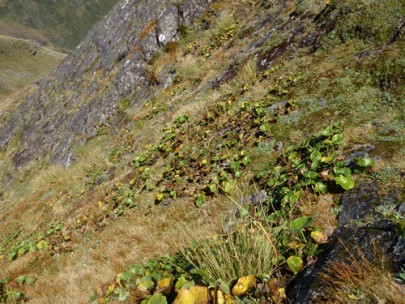Snow banks
In this section

Snow bank vegetation on Mt O’Shanessy, Westland (Rowan Buxton)
Snow bank communities occur in the alpine zone in situations where snow lies for up to seven months of the year. They are saturated well into summer, and often have loamy soils with capacity to hold water for much of the remainder of the year, so that they tend to accumulate organic matter (Talbot 1992). They support small grasses and herbs. Some of the prominent plant species in snow banks are mountain snow tussock (Chionochloa oreophila), silky alpine buttercup (Ranunculus sericophyllus) and white mountain daisy (Celmisia allanii).
Notable flora and fauna
Threatened plants include the nationally endangered Myosotis cheesemanii and the recovering Ranunculus godleyanus.
Threat status
Not threatened (Holdaway et al. 2012)
Threats
Snowbanks are vulnerable to exotic herbivores, particularly chamois and tahr because of the many palatable large herb species that are characteristic of this ecosystem. Weeds pose very little threat due to the inhospitable climate in the alpine zone. They are dynamic sites which can be altered by various forms of erosion. Receding of snow line as temperatures increase due to global warming may lead to local extinction on lower mountains and/or those in more northern parts. Also some areas, particularly those near ski fields or popular mountaineering routes, may be threatened due to recreation impacts.
Where do they occur?
Snow bank communities occur above treeline on the central Volcanic Plateau, Mt Taranaki, and from Nelson to Fiordland along the Main Divide of the South Island. There are small snow bank communities on the Inland Kaikoura Range.
Further reading
Burrows CJ 1977. Distribution and composition of plant communities containing Chionochloa oreophilla. New Zealand Journal of Botany 15: 549-563.
Dawson JW 1988. Snow Banks in Forest Vines to Snow Tussocks: The Story of New Zealand Plants. Victoria University Press, Wellington.
Korsten AC 2011. Life at the edge: plant responses to extreme alpine environments. Master thesis University of Otago.
Mark AF 1977. Vegetation of Mount Aspiring National Park, New Zealand. Wellington, National Parks Authority.
Mark AF, Bliss LC 1970. The high-alpine vegetation of Central Otago, New Zealand. New Zealand Journal of Botany 8: 381-451.
Talbot JM, Mark AF, Wilson JB 1992. Vegetation-environment relations in snowbanks on the Rock and Pillar Range, Central Otago. New Zealand Journal of Botany 30: 271-297.
Wardle P 1979. Plants and landscape in Westland National Park. National Parks Science Series No. 3. Wellington, Department of Lands and Survey.
Wilson HD 1976. Vegetation of Mount Cook National Park, New Zealand. Wellington, Lands and Survey Department.


